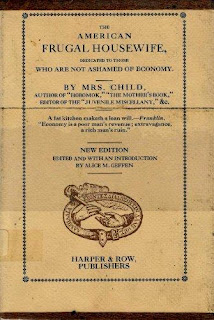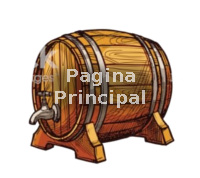 |
| Imagen correspondiente a: Title: The American Frugal Housewife Publisher: Harper & Row Publication Date: 1972 |
BEER
Beer is a good family drink. A handful of hops, to a pailful of water, and a half-pint of molasses, makes good hop beer. Spruce mixed with hops is pleasanter than hops alone. Boxberry, fever-bush, sweet fern, and horseradish make a good and healthy diet-drink. The winter evergreen, or rheumatism weed, thrown in, is very beneficial to humors. Be careful and not mistake kill-lamb for winter-evergreen; they resemble each other. Malt mixed with a few hops makes a weak kind of beer; but it is cool and pleasant; it needs less molasses than hops alone. The rule is about the same for all beer. Boil the ingredients two or three hours, pour in a half-pint of molasses to a pailful, while the beer is scalding hot. Strain the beer, and when about lukewarm, put a pint of lively yeast to a barrel. Leave the bung loose till the beer is done working; you can ascertain this by observing when the froth subsides. If your family be large, and the beer will be drank rapidly, it may as well remain in the barrel; but if your family be small, fill what bottles you have with it; it keeps better bottled. A raw potato or two, cut up and thrown in, while the ingredients are boiling, is said to make beer spirited.
Ginger beer is made in the following proportions:—One cup of ginger, one pint of molasses, one pail and a half of water, and a cup of lively yeast. Most people scald the ginger in half a pail of water, and then fill it up with a pailful of cold; but in very hot weather some people stir it up cold. Yeast must not be put in till it is cold, or nearly cold. If not to be drank within twenty-four hours, it must be bottled as soon as it works.
Table beer should be drawn off into stone jugs, with a lump of white sugar in each, securely corked. It is brisk and pleasant, and continues good several months.
Potato cheese is much sought after in various parts of Europe. I do not know whether it is worth seeking after, or not. The following is the receipt for making:—Select good white potatoes, boil them, and, when cold, peel and reduce them to a pulp with a rasp or mortar; to five pounds of this pulp, which must be very uniform and homogeneous, add a pint of sour milk and the requisite portion of salt; knead the whole well, cover it, and let it remain three or four days, according to the season; then knead it afresh, and place the cheeses in small baskets, when they will part with their superfluous moisture; dry them in the shade, and place them in layers in large pots or kegs, where they may remain a fortnight. The older they are, the finer they become.
This cheese has the advantage of never engendering worms, and of being preserved fresh for many years, provided it is kept in a dry place, and in well closed vessels.
(The American Frugal Housewife, Lydia M. Child. Paginas 86 y 87, 12 edicion, ampliado y corregido por el autor, 1832)
CERVEZA
La cerveza es una buena bebida familiar. Un puñado de lúpulos, un balde de agua y media pinta de melaza, hace una buena cerveza de lúpulo. La picea mezclada con lúpulo es más agradable que el lúpulo solo. Boxberry (Gaultheria procumbens), arbusto febril (Ilex verticillata), helecho dulce (Comptonia) y rábano picante (Armoracia rusticana) hacen una buena y saludable bebida dietética. El árbol de hoja perenne de invierno, o malezas de reumatismo, arrojado, es muy beneficioso para los humores. Ten cuidado y no confundas el kill-lamb (Kalmia angustifolia) para winter-evergreen; se parecen el uno al otro. La malta mezclada con unos pocos lúpulos es un tipo de cerveza débil; pero es genial y agradable; necesita menos melaza que solo el lúpulo. La regla es casi la misma para toda la cerveza. Hierva los ingredientes durante dos o tres horas, vierta media pinta de melaza en un recipiente, mientras la cerveza está hirviendo. Cuele la cerveza, y cuando esté tibio, ponga una pinta de levadura viva en un barril. Deje el tapón suelto hasta que la cerveza termine de funcionar; puedes determinar esto observando cuando la espuma disminuye. Si su familia es grande, y la cerveza se bebe rápidamente, puede permanecer en el barril; pero si su familia es pequeña, llene las botellas que tiene con ella; se mantiene mejor embotellado. Una patata cruda o dos, cortadas y echadas, mientras los ingredientes están hirviendo, se dice que hacen cerveza espirituosa.
La cerveza de jengibre se elabora en las siguientes proporciones: una taza de jengibre, una pinta de melaza, un cubo y medio de agua y una taza de levadura viva. La mayoría de las personas escaldan el jengibre en medio cubo de agua, y luego lo llenan con un balde de frío; pero cuando hace mucho calor, algunas personas lo despiertan frío. La levadura no se debe colocar hasta que esté fría o casi fría. Si no se bebe dentro de las veinticuatro horas, debe ser embotellado tan pronto como funcione.
La cerveza de mesa debe extraerse en jarras de piedra, con un terrón de azúcar blanco en cada una, bien tapadas con corcho. Es rápido y agradable, y continúa bien varios meses.
El queso de patata es muy buscado en varias partes de Europa. No sé si vale la pena buscarlo, o no. El siguiente es la receta para hacer: -Seleccione buenas papas blancas, hiérvalas y, cuando esté fría, pélelas y póngalas a pulpa con una escofina o mortero; a cinco libras de esta pulpa, que debe ser muy uniforme y homogénea, agregue una pinta de leche agria y la porción requerida de sal; amasa bien todo, cúbrelo y déjalo reposar tres o cuatro días, según la estación; luego amasarlo de nuevo, y coloque los quesos en pequeñas cestas, cuando se desprenderán de su humedad superflua; Séquelos a la sombra y colóquelos en capas en ollas grandes o barriles, donde pueden permanecer una quincena. Cuanto más viejos son, más refinados se vuelven.
Este queso tiene la ventaja de nunca engendrar gusanos y de conservarse fresco durante muchos años, siempre que se conserve en un lugar seco y en recipientes bien cerrados.

Sobre la autora, Lydia Maria Child:
Lydia Maria Child (nacida Lydia Maria Francis, 11 de febrero de 1802 - 20 de octubre de 1880) fue una abolicionista, activista de los derechos de la mujer y de los nativos americanos, novelista, periodista y opositora al expansionismo estadounidense.
Sus escritos —manuales domésticos y ficción— tuvieron un considerable público en la primera mitad del siglo XIX. En ocasiones escandalizó a sus lectores al tratar temas como el dominio masculino y la supremacía blanca en algunas de sus historias.
Extracto de The Project Gutenberg eBook,
The American Frugal Housewife, by Lydia M. Child









